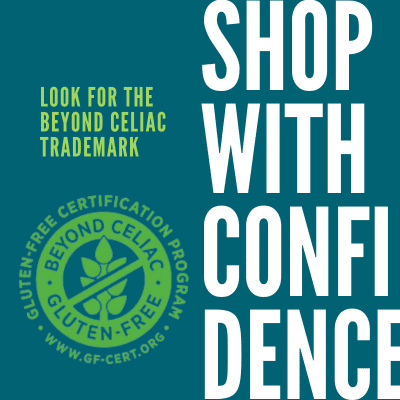Keeping a Safe Gluten-Free Kitchen
How to Make (and Keep) Your Kitchen Gluten-Free
By Suzy Schurr of Figs and Function
If you’ve been diagnosed with celiac disease or have an intolerance to gluten, you know how overwhelming the process of going gluten-free can be. Not only do we worry about ingredients and cross-contamination when other people are cooking for us, but we also worry about getting accidentally glutened in our own homes.
Here’s my step-by-step plan to keep your home as safe for gluten-free eating as possible.
Step 1: Invest in a label maker and Post-It notes
I think one of the first things I did after I was diagnosed with celiac disease was buy a label maker. This, along with Post-It notes, is your first defense against cross-contamination in your house. Certain foods will attract stray crumbs from a knife or spoon, so you’ll need to mark which ones must stay gluten-free. I have my own labeled jars of almond butter, jelly, mayonnaise and butter.
Step 2: Purchase a toaster that will be only for gluten-free bread and waffles
It’s your decision whether you feel comfortable enough to place it next to the non gluten-free toaster. As my children got older, they were more aware of my need to remain gluten-free, and I am now able to keep my toaster on the counter next to theirs. There were many years that I kept the gluten-free toaster in the cabinet, and pulled it out only when I was making myself gluten-free toast or a gluten-free waffle.
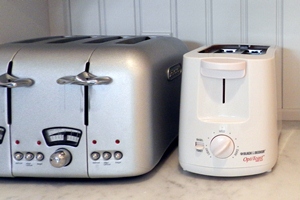
Step 3: Keep healthy snacks visible
We used to have a “junk” drawer filled with snacks. I called it a junk drawer, not because there were junky snacks in there, but because bags of nuts, granola bars and boxes of assorted crackers, both gluten-free and non gluten-free were all thrown haphazardly into this one drawer. I now find that if I keep the healthy snacks in clear glass jars where they are seen, then whenever we are looking for something to nibble on, more often than not, my family and I will go for these. So I like to keep nuts, seeds, dried fruit, fruit bars, and multi-grain gluten-free crackers visible. The nuts and seeds are great for energy and healthy fats, while the dried fruit and fruit bars will provide good carbs. Hummus on gluten-free crackers and an apple make a great afternoon snack.
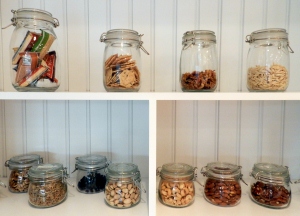
Step 4: Keep jars of gluten-free grains and baking supplies labeled
Fill jars with your family’s favorite gluten-free grains and label the jars. Our favorites are brown rice and quinoa. Remember, grains need to be rinsed before you cook them to remove the dust and pebbles. Quinoa, in particular, has a bitter coating called saponin, which is important to rinse away. You can enjoy quinoa by itself as it offers a complete protein source, but it’s also very tasty alongside steamed or sautéed vegetables. Brown rice, on the other hand, will become a complete protein if you combine it with beans or lentils.
I often make my own gluten-free flour mix and store it in a large labeled jar. There are a ton of different recipes out there, but I really love the one that Silvana Nardone created. She is editor-in-chief of Easy Eatsmagazine and author of Cooking for Isaiah,a gluten-free, dairy-free cookbook. The recipes are kid-friendly, yet sophisticated kid-friendly. So it’s perfect for the entire family to enjoy, whether they eat a gluten-free, dairy-free diet or not.
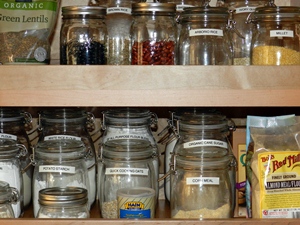
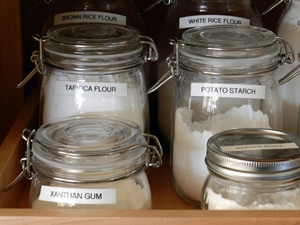
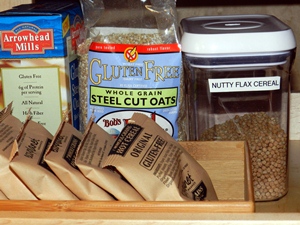
Step 5: Refrigerated Items
I usually like to purchase ketchup and mustard in squeeze bottles because they’re a “safer” (cross-contamination wise) way of dispensing condiments. It’s a little less economical because the last few teaspoons are difficult to retrieve from the empty bottle. But to be safe, it can be worth the extra pennies. Some jarred items and a separate container of butter are labeled with my name on each. My family knows not to put a crumb-laden knife in my jar.
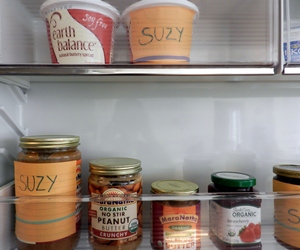
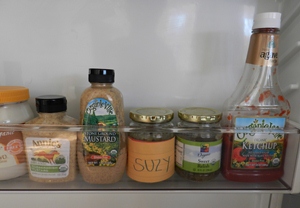
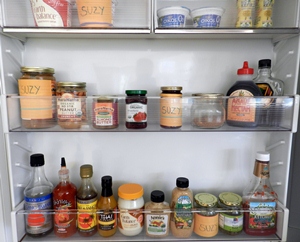
Step 6: Keep the counter clean
This step will become habit. I wipe the counter with hot soapy water before I prepare any food. Not only will this keep germs away, but it will also prevent possible cross-contamination from crumbs accidentally left behind.
So, my gluten-free compadres, I hope this plan will help you get started if you or someone in your family is beginning a gluten-free diet. It’s also a reminder of how important it is to keep the gluten-free food separate from the gluten-filled food. I wish you all the best on this journey that is now a part of your life. With your health and peace of mind, life now will be oh so yummy!
About Suzy Schurr
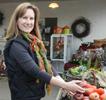 Suzy Schurr is a holistic health coach, level 2 Reiki practitioner and certified yoga instructor offering nutritional coaching. She was diagnosed with celiac disease in 2004. Her blog, Figs and Function, shares health, nutritional and organizational solutions to promote healthy eating, healthy thinking and healthy living.
Suzy Schurr is a holistic health coach, level 2 Reiki practitioner and certified yoga instructor offering nutritional coaching. She was diagnosed with celiac disease in 2004. Her blog, Figs and Function, shares health, nutritional and organizational solutions to promote healthy eating, healthy thinking and healthy living.


